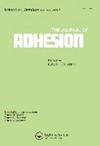Parameters influencing the temporal behavior of adhesion on the build plate in fused filament fabrication
IF 2.3
4区 材料科学
Q2 ENGINEERING, CHEMICAL
引用次数: 0
Abstract
ABSTRACTFused filament fabrication, also known as material extrusion, is an additive manufacturing process used in many industries. Despite its widespread application, common issues like an unwanted deformation of the part to be printed during the process are rarely investigated. These failures, called warping, can be avoided by a sufficient adhesion between build surface and part. Although printing processes can last up to several days, the time dependencies and the mechanism causing adhesion are poorly understood. For this reason, the time dependence of adhesion between polylactic acid and polyamide as printing materials and different building surfaces will be investigated. The adhesion forces can change up to 60% within 20 minutes dependent on the build surface temperature. Higher build surface temperatures lead to a stronger change. These results indicate that besides mechanical adhesion other mechanisms could be involved. Adhesion measurements before and after sandblasting the build surfaces support this. For brass and borosilicate glass as build surface materials, a complete loss of adhesion was observed, whereas it did not change for Pertinax. These overall results lead to the assumption that adhesion occurs because of ionic bond onto brass surfaces and because of hydrogen bond onto borosilicate glass and Pertinax.KEYWORDS: Fused filament fabricationbuild surface adhesionwarping AcknowledgmentsWe would like to thank the working group of Macromolecular and Paper Chemistry of Markus Biesalski and especially Sunna Möhle-Saul for access to DSC measurements and consultation regarding setup and interpretation.Disclosure statementNo potential conflict of interest was reported by the author(s).Additional informationFundingThis work was supported by the Federal Ministry for Economic Affairs and Climate Action within the Central Innovation Programme for small and medium-sized enterprises (SMEs) under Grant 16KN084521.熔丝制造过程中影响构建板粘附时间行为的参数
摘要熔融长丝制造,又称材料挤压,是一种应用于许多行业的增材制造工艺。尽管它的广泛应用,常见的问题,如在过程中被打印的部分的不希望的变形很少被调查。这些故障被称为翘曲,可以通过制造表面和零件之间的充分粘合来避免。虽然印刷过程可以持续数天,但时间依赖性和导致粘连的机制尚不清楚。因此,将研究聚乳酸和聚酰胺作为打印材料与不同建筑表面之间粘附的时间依赖性。附着力可在20分钟内根据构建表面温度变化高达60%。较高的建筑表面温度导致更强的变化。这些结果表明,除了机械粘附外,其他机制也可能参与其中。喷砂前和喷砂后的附着力测量支持这一点。对于黄铜和硼硅酸盐玻璃作为建筑表面材料,观察到完全失去附着力,而对于比蒂诺则没有变化。这些总体结果导致了这样的假设,即由于黄铜表面上的离子键和硼硅酸盐玻璃和比蒂诺上的氢键而发生粘附。我们要感谢Markus Biesalski的大分子和纸张化学工作组,特别是Sunna Möhle-Saul提供DSC测量和关于设置和解释的咨询。披露声明作者未报告潜在的利益冲突。这项工作得到了联邦经济事务和气候行动部在中小型企业中央创新计划(sme)下的资助,资助号为16KN084521。
本文章由计算机程序翻译,如有差异,请以英文原文为准。
求助全文
约1分钟内获得全文
求助全文
来源期刊

Journal of Adhesion
工程技术-材料科学:综合
CiteScore
5.30
自引率
9.10%
发文量
55
审稿时长
1 months
期刊介绍:
The Journal of Adhesion is dedicated to perpetuating understanding of the phenomenon of adhesion and its practical applications. The art of adhesion is maturing into a science that requires a broad, coordinated interdisciplinary effort to help illuminate its complex nature and numerous manifestations.
 求助内容:
求助内容: 应助结果提醒方式:
应助结果提醒方式:


